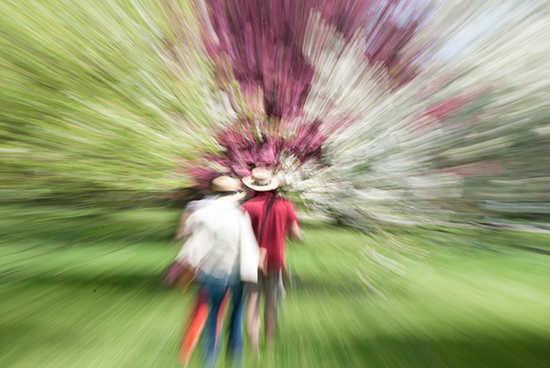WHY ARE SENIORS AT HIGHER RISK FOR FALLS?
Dizziness can happen at any age, but if it results in falling it can be a serious health concern, particularly in older adults.
Studies show that you can take action to reduce dizziness and your risk of falling. Begin by talking with your health care providers to explore medical issues that may be contributing to your symptoms, and exercise to improve your balance and strength.
How Do We Maintain Balance?
Normal balance is dependent on many factors, including multiple systems of the body, as well as external and environmental factors.
The body has three primary sensory systems that work together to create postural stability. With normal brain function, the vestibular system of the inner ear coordinates with the visual system and proprioceptors that sense the position and movement of your body in space. These three systems work together while we perform simple tasks, such as standing and walking, or more complex and dynamic activities, such as yoga or hitting a golf ball accurately.

What Causes Dizziness & Imbalance As We Age?
- Impaired Inner Ear Function
- Cardiovascular Health
- Neurological Disease
- Arthritis
- Mental Status
- Nutrition
- Impaired Vision
- Lifestyle and Environmental Factors
How Does the Inner Ear Create Symptoms?
The inner ear is a complex structure of fluid-filled tubes and chambers. Specialized nerve endings inside these structures sense the position and movement of the head and detect the direction of gravity. Signals sent from the nerves of the vestibular system are critically important to the brain’s ability to control balance in standing and walking. They also control movements of the eyes that make it possible to see clearly while moving.
Anatomical studies have shown that the number of nerve cells in the vestibular system decreases after about age 55. Blood flow to the inner ear also decreases with age. When the vestibular system is damaged, an individual may experience dizziness and balance problems. However, the gradual, age-related loss of vestibular nerve endings can result in balance problems without any associated dizziness. This type of slow loss of vestibular function may be first noticed as difficulty walking or standing, especially in the dark while on soft or uneven surfaces (such as thick carpet or a forest path).
A decline in inner ear function may be caused by a number of conditions, including normal aging, benign paroxysmal positional vertigo (BPPV), infection, Meniere’s disease, or diminished blood flow to specialized nerve cells. Additionally, certain medications such as some antibiotics for severe infections and chemotherapy may damage the inner ear, resulting in temporary or permanent hearing loss, impaired balance, and trouble seeing clearly while in motion. Feelings of dizziness, vertigo, imbalance, and disequilibrium may indicate that the inner ear is not functioning correctly.
Benign Paroxysmal Positional Vertigo (BPPV) is the most common vestibular disorder in older adults and causes a sense of true spinning vertigo triggered by a change of position of the head or body. With this condition the spinning can be triggered by things like tipping your head up or down, quickly rotating your head, bending over, rolling over in bed, or getting in and out of bed. BPPV is a mechanical disorder that occurs when debris, called otoconia, loosen and tumble into the semicircular canals of the inner ear. This event causes false signals to the brain triggering a brief sense of vertigo. The spinning lasts less than a minute and can provoke nausea, vomiting, and imbalance. BPPV can be effectively treated by a Vestibular Physical Therapist with specialized training by using proven techniques, such as the Epley maneuver or canal repositioning techniques, which help return the otoconia to their correct position in the inner ear.
Labyrinthitis is an infection or inflammation of the inner ear that causes severe vertigo lasting 1-2 days, hearing loss, and severe imbalance that can affect walking. Neuronitis is a similar disorder causing vertigo, but it does not affect hearing. Both can be triggered by an upper respiratory infection, virus or flu, or can occur with no obvious cause.
Meniere’s disease causes similar symptoms, including periodic episodes of vertigo, dizziness, and hearing loss. It is thought to be a result of an excess amount of fluid, called endolymph, collecting in the inner ear.

Neurological Diseases – Healthy Brain
Normal orientation also relies on healthy brain function to process, adapt, and interpret changing sensory information from the vestibular system, vision, and body input. The brain must process this information to select appropriate balancing strategies and learn new strategies necessary for changing environments. There are many disorders, such as stroke, Alzheimer’s, Parkinson’s Disease, concussion, and dementia, that interfere with brain function resulting in slower and inaccurate balance reactions. Cognitive deficits are often associated with balance problems, demonstrating the complex nature of performing dynamic balance tasks.
As you can see, balance is very complex and there are a variety of conditions that can put a person at risk of falling. See VeDA’s article Balance and Falls in Older Adults for more information.
Some people may believe feeling off-balance or having dizziness is an unavoidable consequence of aging. Here’s the good news: with proper diagnosis, many of the causes that result in imbalance, dizziness, or falls can be treated or diminished with lifestyle changes.
Start by having a thorough assessment by your primary physician at least once a year. Tell them if you are experiencing dizziness, lightheadedness, vertigo, imbalance, or have suffered a fall. There may be multiple health issues and medication interactions contributing to symptoms of dizziness and imbalance. Making an accurate diagnosis to determine the source of the symptoms may be a complicated task for your physician, and they may refer you to a specialist.
The physician should include checking for specific muscle weakness in the legs and feet or a decline in sensation, which can indicate a need for strengthening or specific footwear.
If you are experiencing dizziness with specific head movements or sitting up in bed you should be screened for BPPV. If your physician concludes that your vestibular, visual, or sensory systems are creating a risk of falling, s/he will refer you to a certified vestibular therapist who specializes in Vestibular Rehabilitation Therapy (VRT). Studies have shown that VRT can help improve balance, decrease dizziness, and decrease fall risk. A vestibular therapist is a physical therapist with specific training in the assessment of balance deficits and inner ear disorders. Exercises provided by a vestibular therapist will be based on the functional impairments that are measured in the therapist’s evaluation of the vestibular and balance systems. The exercises are designed to reduce dizziness associated with movement and improve visual clarity, balance reactions, joint mobility, and strength to decrease fall risk. (See VeDA’s article about Vestibular Rehabilitation.)

It’s essential that you see your eye doctor and make sure your glasses are the correct prescription. If you have bifocal or progressive lenses, you may want to get a pair of glasses with only your distance prescription for outdoor activities, such as walking. Sometimes progressive lenses can make things seem closer or farther away than they really are, which is especially risky when walking down steps or slopes.
It is also important to be screened for diabetes, cataracts, macular degeneration, or neuropathy.
You can also make lifestyle choices that have been shown to improve balance and facilitate good health as we age.
First, it is important to have adequate nutrition, which includes a balanced diet of fruits, vegetables, protein, and low sugar foods. You should also include supplements of Vitamin D 880 IU with calcium to strengthen the bone and reduce the risk of fractures (CDC, Shahar 2009).
Second, it has been shown that staying active and exercising can reduce fall risk in the elderly (Shubert 2011). In community-dwelling adults, a progressive exercise program with a moderate to a high level of balance exercises and cardiovascular conditioning has been shown to be an effective way to reduce falls. Exercise programs may include standing squats, single-leg standing, toe, and heel raises, tandem stance or walking, hip and knee strengthening, walking tasks, and high-level balance tasks such as reaching, turning, and stair-stepping. Tai chi is a form of exercise involving low impact dynamic movements of the arms and legs with reaching and turning, and movement of the torso in repetitive patterns. It not only benefits the body but also is cognitively challenging.
Walking is a beneficial form of exercise, especially when the additional emphasis is placed on increasing stride and speed of steps, which studies have shown to reduce falls in older adults.
Another easy step in reducing falls is to make changes to your home creating a safer environment.
Authors: By Wendy Webb Schoenewald PT, OCS and Viviann C. Bailey MSPT

Leave a Reply